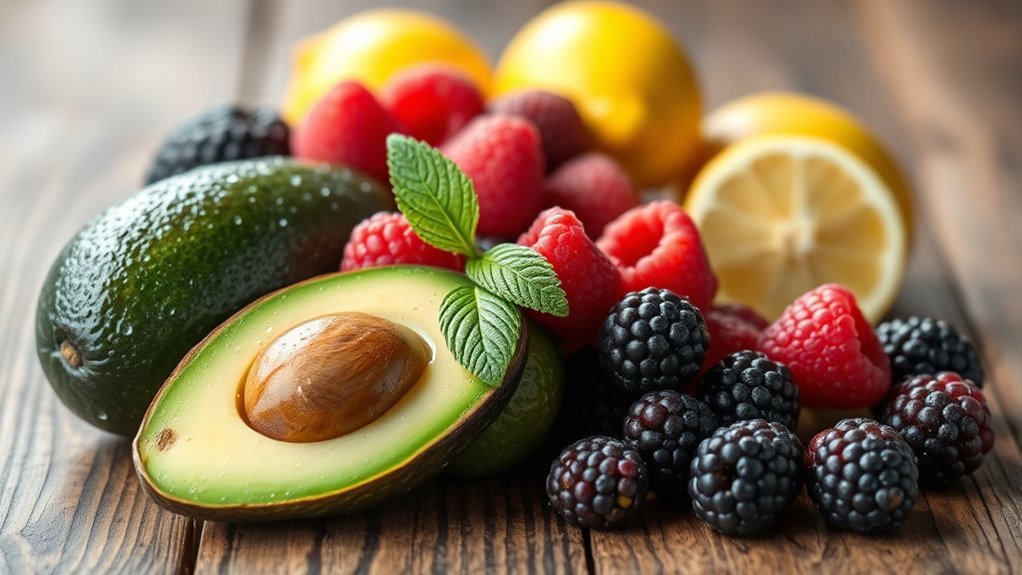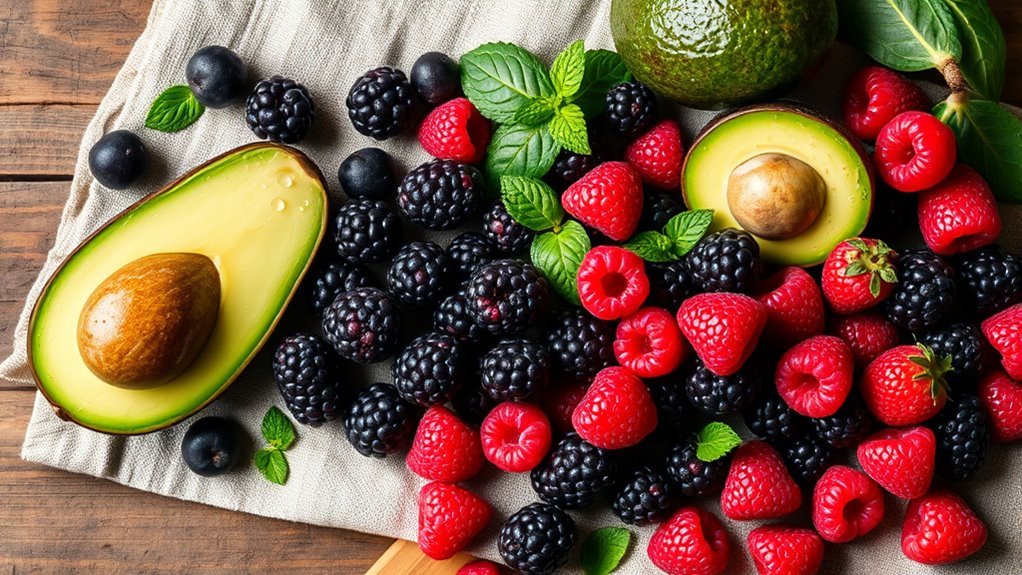Yes, you can eat fruit on the keto diet, but you need to be mindful of your choices. Focus on low-carb options like berries, avocados, and olives, which can fit well within your daily carb limits. It’s important to practice portion control to avoid exceeding your carb intake. By balancing fruit with other low-carb foods, you can satisfy your sweet cravings without compromising your diet. Discover more about incorporating fruit effectively into your keto lifestyle.
Understanding Carbohydrates in Fruits

When you’re following a keto diet, understanding carbohydrates in fruits is essential, as it can greatly impact your daily carb count. Fruits vary widely in carbohydrate content, so it’s vital to choose wisely. For instance, berries tend to have lower carbs compared to bananas or grapes. Additionally, the glycemic index (GI) of fruits plays a significant role in how they affect your blood sugar. Low-GI fruits release sugar slowly into your bloodstream, making them more compatible with a keto lifestyle. By focusing on fruits with lower carbohydrate content and a favorable GI, you can enjoy the flavors of nature while still adhering to your dietary goals. Balancing fruit intake with your overall carb limits is key to maintaining your freedom on keto.
Keto-Friendly Fruits to Enjoy

What fruits can you enjoy while sticking to a keto diet? You’ll be pleased to know there are several options! Keto-approved berries like strawberries, raspberries, and blackberries are fantastic choices. They’re not only delicious but also low in carbs, making them perfect for satisfying your sweet tooth without derailing your diet. Avocados, while technically a fruit, are another excellent low carb fruit that’s packed with healthy fats and nutrients. Other options include tomatoes and olives, both of which can add flavor and variety to your meals. Just remember to keep portion sizes in check to maintain your carb limit. Enjoy the freedom to indulge in these tasty fruits while staying true to your keto lifestyle!
Strategies for Incorporating Fruit Into Your Keto Diet

Incorporating fruit into your keto diet can be a delicious way to enhance your meals while still adhering to your carb limits. Start by practicing fruit portioning; measure out servings to avoid overindulgence. Aim for low-carb options like berries, which can add flavor without breaking your carb bank. Consider seasonal selections, as fruits peak in flavor and nutrients at different times of the year. This not only keeps your meals interesting but also supports local agriculture. Experiment with using fruits in salads, smoothies, or as toppings for keto-friendly desserts. Balancing your fruit intake allows you to enjoy the sweetness while staying mindful of your overall carb goals, ensuring you maintain that sense of freedom in your diet.
Satisfying Sweet Cravings on Keto
While sticking to a keto diet often means cutting out traditional sweets, there are plenty of ways to satisfy your sweet cravings without derailing your progress. Utilizing sugar substitutes like stevia or erythritol can help you create delicious low carb desserts that keep you on track.
Here’s a quick guide to some delightful options:
| Dessert Type | Ingredients | Sweetener |
|---|---|---|
| Keto Chocolate Mousse | Heavy cream, cocoa powder | Erythritol |
| Almond Flour Brownies | Almond flour, eggs | Stevia |
| Berry Parfait | Berries, Greek yogurt | Monk fruit |
| Coconut Macaroons | Shredded coconut, egg | Xylitol |
| Chia Seed Pudding | Chia seeds, almond milk | Allulose |
Enjoy these treats while staying true to your keto lifestyle!
Tips for Balancing Fruit Intake on a Low-Carb Diet
As you navigate the keto diet, it’s crucial to find a balance when it comes to fruit intake, especially since many fruits are naturally high in sugars. To enjoy fruit without compromising your carb limits, consider the following tips:
- Focus on low-carb fruits: Berries, avocados, and olives are excellent choices due to their lower sugar content.
- Practice fruit portioning: Keep portions small to maintain your carb count while still enjoying the taste of fruit.
- Prioritize nutrient density: Choose fruits that offer vitamins and minerals to guarantee you’re getting essential nutrients while on a low-carb diet.


